This document contains the syllabus and contents for an Operating System Concepts course. The syllabus provides details on class time, location, textbook, and grading. The contents cover 11 chapters on operating system concepts including computer system structures, processes, memory management, and file systems. The introduction discusses the role of operating systems and how they balance convenient use and efficient operation.




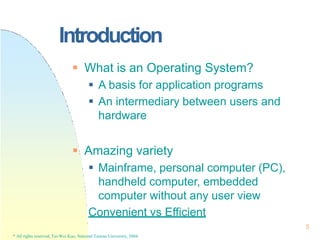
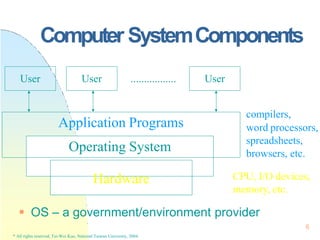








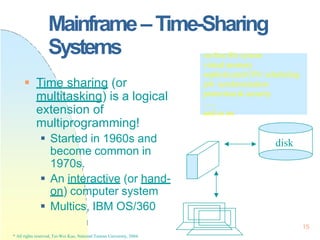


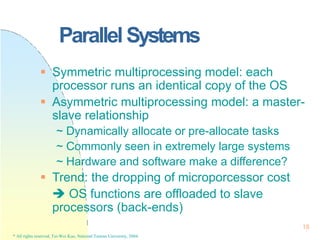





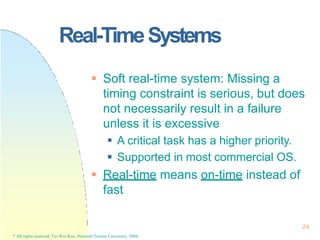











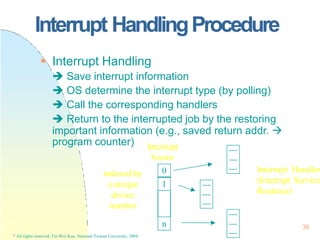



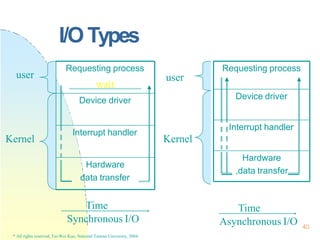




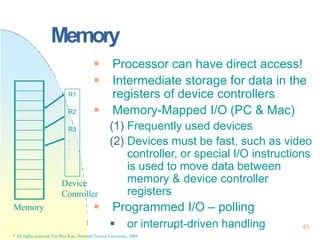

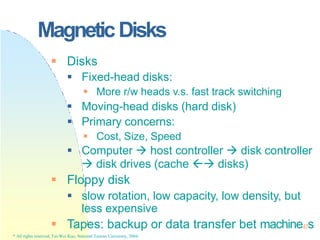













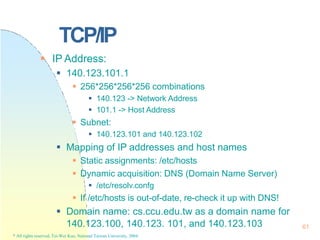





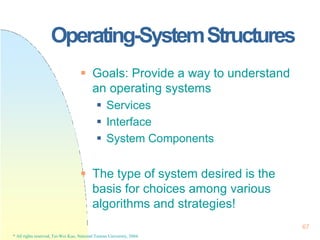

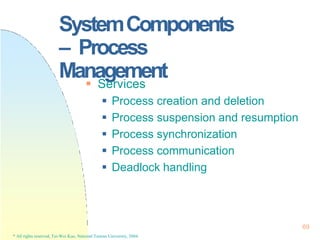

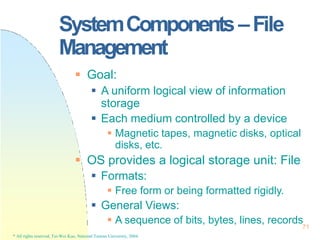
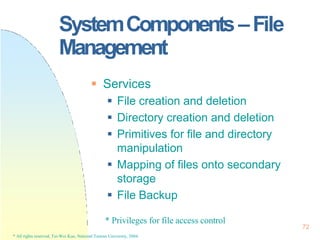



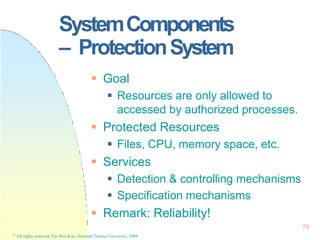





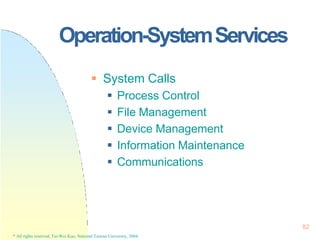

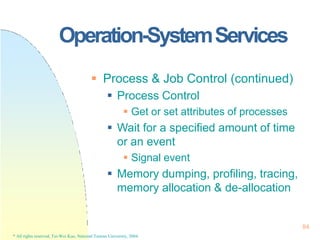

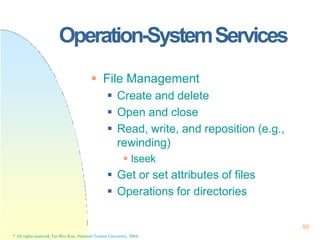
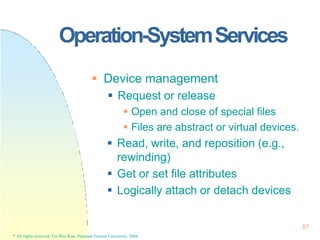


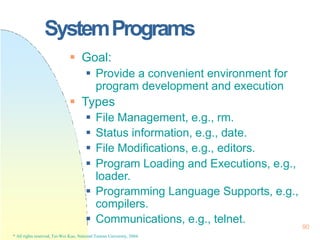
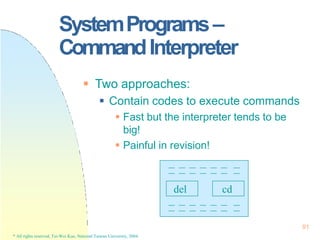


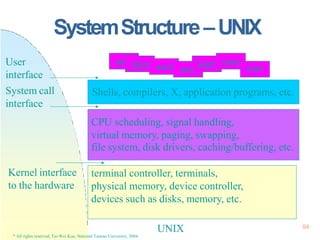


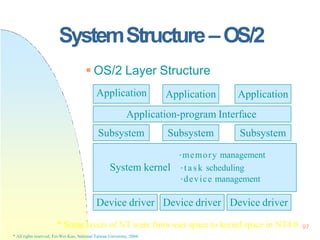


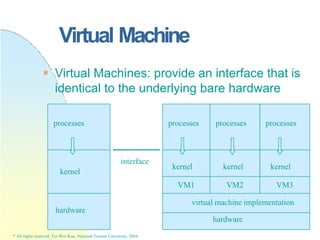







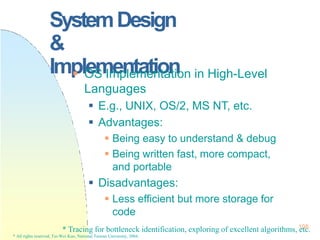
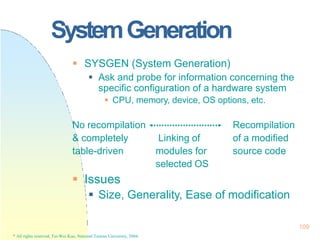


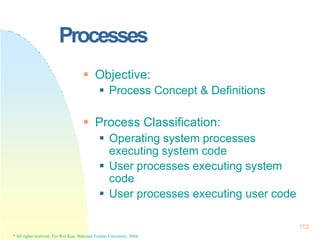


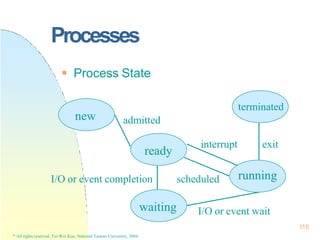

![Processes
pointer
process state
pc
register
PCB: The repository for any information
that may vary from process to process
PCB[]
0
1
2
NPROC-1
117
* All rights reserved, Tei-Wei Kuo, National Taiwan University, 2004.](https://image.slidesharecdn.com/operatingsystemconceptspdfdrive-230209051248-f2ea019f/85/Operating-System-Concepts-PDFDrive-pptx-117-320.jpg)
![Processes
118
* All rights reserved, Tei-Wei Kuo, National Taiwan University, 2004.
Process Control Block (PCB) – An Unix
Example
proc[i]
Everything the system must know when the
process is swapped out.
pid, priority, state, timer counters, etc.
.u
Things the system should know when process
is running
signal disposition, statistics accounting, files[], etc.](https://image.slidesharecdn.com/operatingsystemconceptspdfdrive-230209051248-f2ea019f/85/Operating-System-Concepts-PDFDrive-pptx-118-320.jpg)
![Processes
Example: 4.3BSD
text
structure
proc[i]
entry
page
table Code Segment
Data Segment
PC
heap
user stack
argv, argc,…
sp
.u
per-process
kernel stack
p_textp
x_caddr
p_p0br
u_proc
p_addr
Red
Zone
119
* All rights reserved, Tei-Wei Kuo, National Taiwan University, 2004.](https://image.slidesharecdn.com/operatingsystemconceptspdfdrive-230209051248-f2ea019f/85/Operating-System-Concepts-PDFDrive-pptx-119-320.jpg)
![Processes
Example: 4.4BSD
proc[i]
entry
process grp
…
file descriptors
VM space region lists
page
table Code Segment
Data Segment
heap
user stack
argv, argc,…
.u
per-process
kernel stack
p_p0br
p_addr
u_proc 120
* All rights reserved, Tei-Wei Kuo, National Taiwan University, 2004.](https://image.slidesharecdn.com/operatingsystemconceptspdfdrive-230209051248-f2ea019f/85/Operating-System-Concepts-PDFDrive-pptx-120-320.jpg)










![CooperatingProcesses
A Consumer-Producer Example:
Bounded buffer or unbounded buffer
Supported by inter-process
communication (IPC) or by hand coding
0
1
2
n-1
n-2
131
* All rights reserved, Tei-Wei Kuo, National Taiwan University, 2004.
in
ozut
buffer[0…n-1]
Initially,
in=out=0;](https://image.slidesharecdn.com/operatingsystemconceptspdfdrive-230209051248-f2ea019f/85/Operating-System-Concepts-PDFDrive-pptx-131-320.jpg)
![CooperatingProcesses
132
* All rights reserved, Tei-Wei Kuo, National Taiwan University, 2004.
Producer:
while (1) {
/* produce an item nextp */
while (((in+1) % BUFFER_SIZE) == out)
; /* do nothing */
buffer[ in ] = nextp;
in = (in+1) % BUFFER_SIZE;
}](https://image.slidesharecdn.com/operatingsystemconceptspdfdrive-230209051248-f2ea019f/85/Operating-System-Concepts-PDFDrive-pptx-132-320.jpg)
![CooperatingProcesses
133
* All rights reserved, Tei-Wei Kuo, National Taiwan University, 2004.
Consumer:
while (1) {
while (in == out)
; /* do nothing */
nextc = buffer[ out ];
out = (out+1) % BUFFER_SIZE ;
/* consume the item in nextc */
}](https://image.slidesharecdn.com/operatingsystemconceptspdfdrive-230209051248-f2ea019f/85/Operating-System-Concepts-PDFDrive-pptx-133-320.jpg)



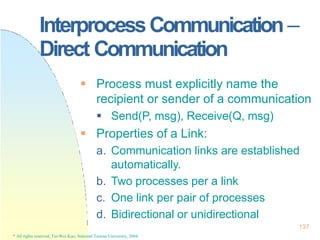
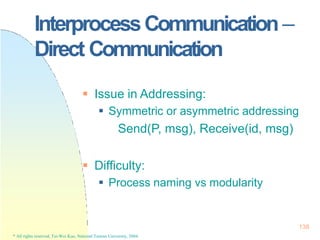







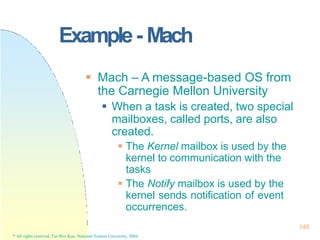



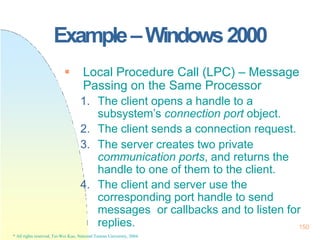

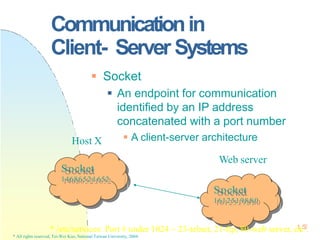
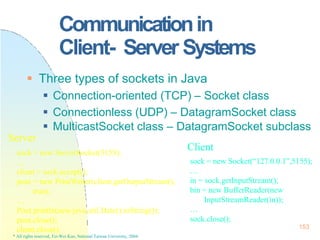



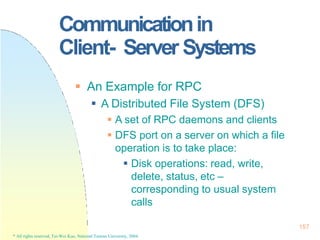




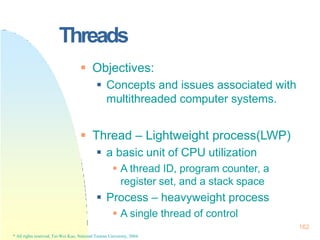
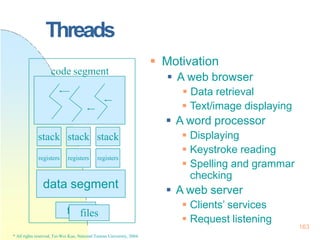



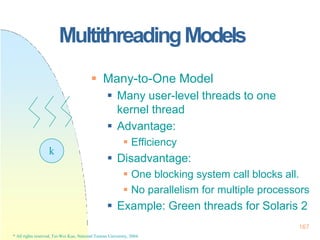



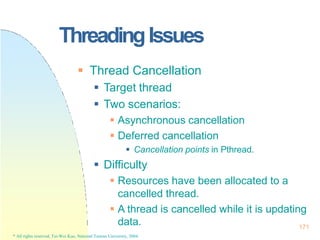




![Pthreads
}
* All rights reserved, Tei-Wei Kuo, National Taiwan University, 2004.
176
#include <pthread.h>
main(int argc, char *argv[]) {
…
pthread_attr_init(&attr);
pthread_create(&tid, &attr, runner, argv[1]);
pthread_join(tid, NULL);
… }
void *runner(void *param) {
int i, upper = atoi(param), sum = 0;
if (upper > 0)
for(i=1;i<=upper,i++)
sum+=i;
pthread_exit(0);](https://image.slidesharecdn.com/operatingsystemconceptspdfdrive-230209051248-f2ea019f/85/Operating-System-Concepts-PDFDrive-pptx-176-320.jpg)
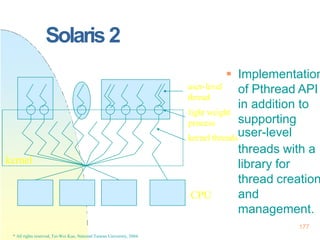







![Java
185
* All rights reserved, Tei-Wei Kuo, National Taiwan University, 2004.
class Summation extends Thread
{ public Summation(int n) {
upper = n; }
public void run() {
int sum = 0;
… }
…}
public class ThreadTester
{ …
Summation thrd = new
Summation(Integer.ParseInt(args[0]));
thrd.start();
…}](https://image.slidesharecdn.com/operatingsystemconceptspdfdrive-230209051248-f2ea019f/85/Operating-System-Concepts-PDFDrive-pptx-185-320.jpg)











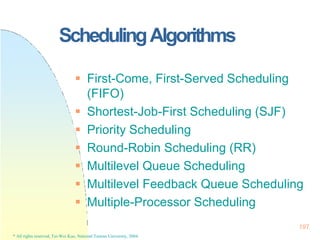


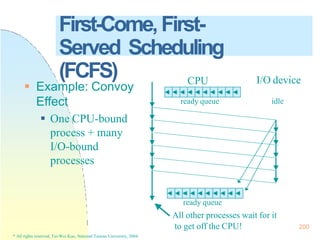
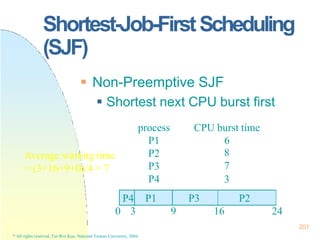








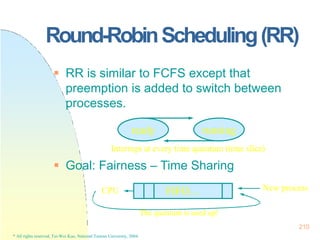














![225
Real-TimeScheduling
Earliest Deadline First Scheduling
(EDF)
Processes with closer deadlines have
higher priorities.
( priority (i ) (1/ di ))
An optimal dynamic-priority-driven
scheduling algorithm for periodic and
aperiodic processes!
Liu & Layland [JACM 73] showed that EDF is optimal in the sense that a process set is
scheduled by EDF if its CPU utilization is no larger than 100%.
* All rights reserved, Tei-Wei Kuo, National Taiwan University, 2004.
i
i
P
C ](https://image.slidesharecdn.com/operatingsystemconceptspdfdrive-230209051248-f2ea019f/85/Operating-System-Concepts-PDFDrive-pptx-225-320.jpg)
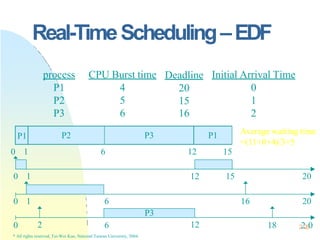










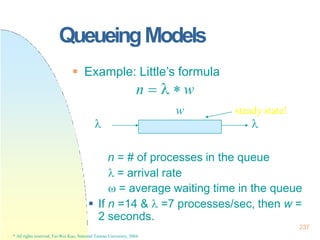

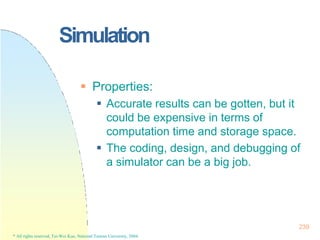





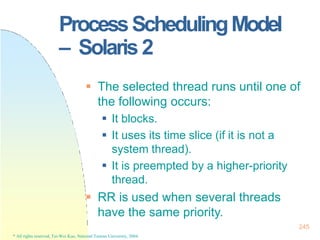

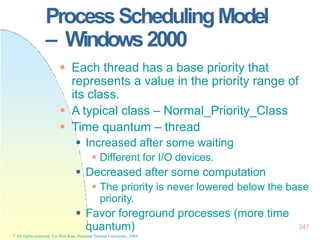
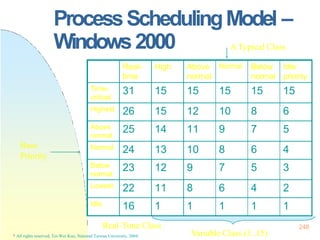



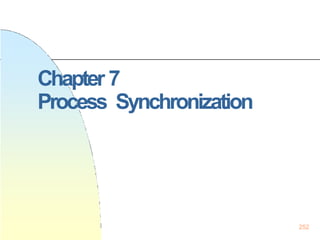

![ProcessSynchronization
A Consumer-Producer Example
Consumer:
while (1) {
while (counter == 0)
;
nextc = buffer[out];
out = (out +1) % BUFFER_SIZE;
counter--;
consume an item in nextc;
}
Producer
while (1) {
while (counter == BUFFER_SIZE)
;
produce an item in nextp;
….
buffer[in] = nextp;
in = (in+1) % BUFFER_SIZE;
counter++;
}](https://image.slidesharecdn.com/operatingsystemconceptspdfdrive-230209051248-f2ea019f/85/Operating-System-Concepts-PDFDrive-pptx-254-320.jpg)





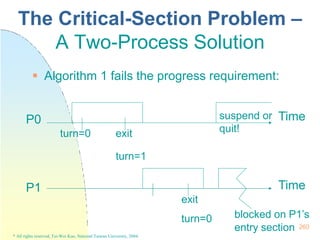
![261
* All rights reserved, Tei-Wei Kuo, National Taiwan University, 2004.
Algorithm 2
Idea: Remember the state
of each process.
flag[i]==true Pi is ready
to enter its critical section.
Algorithm 2 fails the
progress requirement
when
flag[0]==flag[1]==true;
the exact timing of the
two processes?
The Critical-Section Problem –
A Two-Process Solution
flag[i]=true;
while (flag[j]) ;
critical section
flag[i]=false;
remainder section
} while (1);
do {
Initially, flag[0]=flag[1]=false
* The switching of “flag[i]=true” and “while (flag[j]);”.](https://image.slidesharecdn.com/operatingsystemconceptspdfdrive-230209051248-f2ea019f/85/Operating-System-Concepts-PDFDrive-pptx-261-320.jpg)
![ Algorithm 3
Idea: Combine the
ideas of Algorithms 1
and 2
When (flag[i] &&
turn=i), Pj must wait.
Initially,
flag[0]=flag[1]=false,
and turn = 0 or 1
262
* All rights reserved, Tei-Wei Kuo, National Taiwan University, 2004.
The Critical-Section Problem –
A Two-Process Solution
flag[i]=true;
turn=j;
while (flag[j] && turn==j) ;
critical section
flag[i]=false;
remainder section
} while (1);
do {](https://image.slidesharecdn.com/operatingsystemconceptspdfdrive-230209051248-f2ea019f/85/Operating-System-Concepts-PDFDrive-pptx-262-320.jpg)

![ Bakery Algorithm
Originally designed for distributed
systems
Processes which are ready to enter
their critical section must take a
number and wait till the number
becomes the lowest.
int number[i]: Pi’s number if it is
nonzero.
boolean choosing[i]: Pi is taking a
number.
264
* All rights reserved, Tei-Wei Kuo, National Taiwan University, 2004.
The Critical-Section Problem –
A Multiple-Process Solution](https://image.slidesharecdn.com/operatingsystemconceptspdfdrive-230209051248-f2ea019f/85/Operating-System-Concepts-PDFDrive-pptx-264-320.jpg)
![•An observation: If Pi is in its
critical section, and Pk (k != i) has
already chosen its number[k],
then (number[i],i) < (number[k],k).
choosing[i]=true;
number[i]=max(number[0], …number[n-1])+1;
choosing[i]=false;
for (j=0; j < n; j++)
while choosing[j] ;
while (number[j] != 0 && (number[j],j)<(number[i],i)) ;
critical section
number[i]=0;
remainder section
} while (1);
do {
The Critical-Section Problem –
A Multiple-Process Solution](https://image.slidesharecdn.com/operatingsystemconceptspdfdrive-230209051248-f2ea019f/85/Operating-System-Concepts-PDFDrive-pptx-265-320.jpg)



![waiting[i]=true;
key=true;
while (waiting[i] && key)
key=TestAndSet(lock);
waiting[i]=false;
critical section;
j= (i+1) % n;
while(j != i) && (not waiting[j])
j= (j+1) % n;
If (j=i) lock=false;
else waiting[j]=false;
remainder section
} while (1);
do {
SynchronizationHardware
Mutual Exclusion
Pass if key == F
or waiting[i] == F
Progress
Exit process
sends a process in.
Bounded Waiting
Wait at most n-1
times
Atomic TestAndSet is
hard to implement in a
multiprocessor
environment.](https://image.slidesharecdn.com/operatingsystemconceptspdfdrive-230209051248-f2ea019f/85/Operating-System-Concepts-PDFDrive-pptx-269-320.jpg)



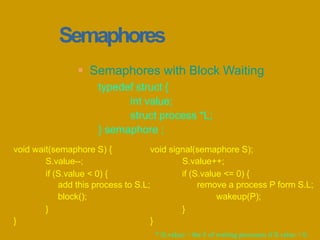






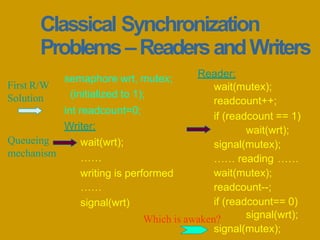

![Classical Synchronization
Problems–Dining-Philosophers
semaphore chopstick[5];
do {
wait(chopstick[i]);
wait(chopstick[(i + 1) % 5 ]);
… eat …
signal(chopstick[i]);
signal(chopstick[(i+1) % 5]);
…think …
} while (1);](https://image.slidesharecdn.com/operatingsystemconceptspdfdrive-230209051248-f2ea019f/85/Operating-System-Concepts-PDFDrive-pptx-282-320.jpg)


![Critical Regions
285
* All rights reserved, Tei-Wei Kuo, National Taiwan University, 2004.
B – condition
count < 0
S – statements
Region v when B do S;
Variable v – shared among processes
and only accessible in the region
struct buffer {
item pool[n];
int count, in, out;
};
Example: Mutual Exclusion
region v when (true) S1;
region v when (true) S2;](https://image.slidesharecdn.com/operatingsystemconceptspdfdrive-230209051248-f2ea019f/85/Operating-System-Concepts-PDFDrive-pptx-285-320.jpg)
![Critical Regions–Consumer-
Producer
286
* All rights reserved, Tei-Wei Kuo, National Taiwan University, 2004.
Producer:
region buffer when
(count < n) {
pool[in] = nextp;
in = (in + 1) % n;
count++;
}
Consumer:
region buffer when
(count > 0) {
nextc = pool[out];
out = (out + 1) % n;
count--;
}
struct buffer {
item pool[n];
int count, in, out;
};](https://image.slidesharecdn.com/operatingsystemconceptspdfdrive-230209051248-f2ea019f/85/Operating-System-Concepts-PDFDrive-pptx-286-320.jpg)


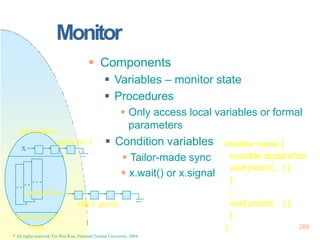

![Monitor –Dining-Philosophers
} 291
* All rights reserved, Tei-Wei Kuo, National Taiwan University, 2004.
monitor dp {
enum {thinking, hungry, eating} state[5];
condition self[5];
void pickup(int i) {
stat[i]=hungry;
test(i);
if (stat[i] != eating)
self[i].wait;
}
void putdown(int i) {
stat[i] = thinking;
test((i+4) % 5);
test((i + 1) % 5);
Pi:
dp.pickup(i);
… eat …
dp.putdown(i);](https://image.slidesharecdn.com/operatingsystemconceptspdfdrive-230209051248-f2ea019f/85/Operating-System-Concepts-PDFDrive-pptx-291-320.jpg)
![Monitor –Dining-Philosophers
292
* All rights reserved, Tei-Wei Kuo, National Taiwan University, 2004.
stat[i] = eating;
self[i].signal();
}
}
void init() {
for (int i=0; i < 5; i++)
state[i] = thinking;
}
void test(int i) {
if (stat[(i+4) % 5]) != eating &&
stat[i] == hungry &&
state[(i+1) % 5] != eating) {
No deadlock!
But starvation could occur!](https://image.slidesharecdn.com/operatingsystemconceptspdfdrive-230209051248-f2ea019f/85/Operating-System-Concepts-PDFDrive-pptx-292-320.jpg)


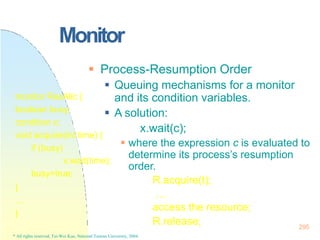







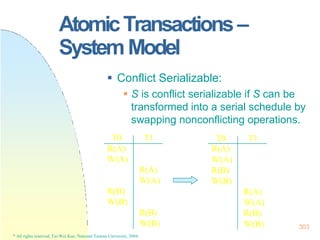
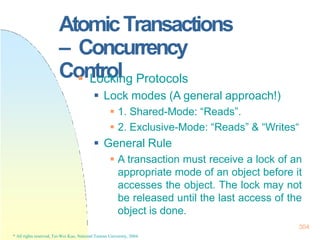

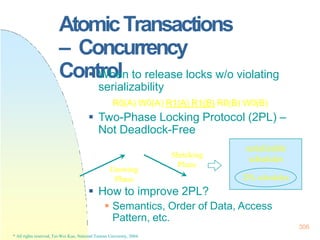





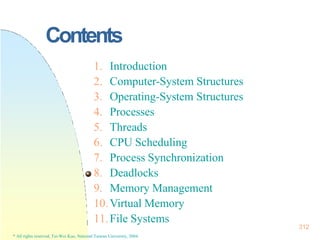




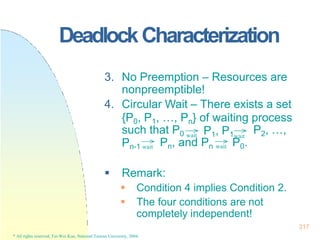
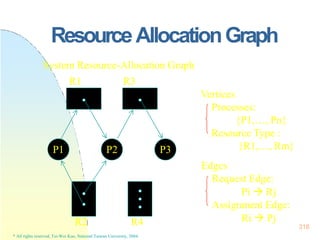





![DeadlockPrevention
Disadvantage:
Low Resource Utilization
Starvation
Tape Drive & Disk Disk & Printer
Hold and Wait
Acquire all needed resources before its
execution.
Release allocated resources before
request additional resources!
[ Tape Drive Disk ] [ Disk & Printer ]
Hold Them All
324
* All rights reserved, Tei-Wei Kuo, National Taiwan University, 2004.](https://image.slidesharecdn.com/operatingsystemconceptspdfdrive-230209051248-f2ea019f/85/Operating-System-Concepts-PDFDrive-pptx-324-320.jpg)




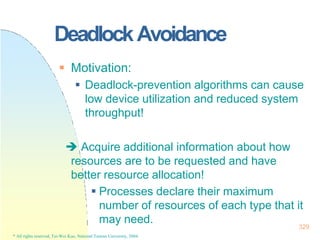





![DeadlockAvoidance–Banker’s
Algorithm
Need [i,j] = Max [i,j] – Allocation [i,j] 335
* All rights reserved, Tei-Wei Kuo, National Taiwan University, 2004.
If Max [i,j] = k, process Pi may request at most k
instances of resource type Rj.
Allocation [n,m]
If Allocation [i,j] = k, process Pi is currently
allocated k instances of resource type Rj.
Need [n,m]
If Need [i,j] = k, process Pi may need k more
instances of resource type Rj.
Available [m]
If Available [i] = k, there are k instances of
resource type Ri available.
Max [n,m]
n: # of
processes,
m: # of
resource
types](https://image.slidesharecdn.com/operatingsystemconceptspdfdrive-230209051248-f2ea019f/85/Operating-System-Concepts-PDFDrive-pptx-335-320.jpg)
![DeadlockAvoidance–Banker’s
Algorithm
X < Y if X ≦ Y and Y≠ X
* All rights reserved, Tei-Wei Kuo, National Taiwan University, 2004.
336
Safety Algorithm – A state is safe??
1. Work := Available & Finish [i] := F, 1 ≦ i ≦ n
2. Find an i such that both
1. Finish [i] =F
2. Need[i] ≦ Work
If no such i exist, then goto Step4
3. Work := Work + Allocation[i]
Finish [i] := T; Goto Step2
4. If Finish [i] = T for all i, then the system is in
a safe state.
Where Allocation[i] and Need[i] are the i-th row of
Allocation and Need, respectively, and
X ≦ Y if X[i] ≦ Y[i] for all i,
n: # of
processes,
m: # of
resource
types](https://image.slidesharecdn.com/operatingsystemconceptspdfdrive-230209051248-f2ea019f/85/Operating-System-Concepts-PDFDrive-pptx-336-320.jpg)
![DeadlockAvoidance–Banker’s
Algorithm
337
* All rights reserved, Tei-Wei Kuo, National Taiwan University, 2004.
Resource-RequestAlgorithm
Requesti [j] =k: Pi requests k instance of resource type Rj
1. If Requesti ≦ Needi, then Goto Step2; otherwise, Trap
2. If Requesti ≦ Available, then Goto Step3; otherwise, Pi
must wait.
3. Have the system pretend to have allocated resources to
process Pi by setting
Available := Available – Requesti;
Allocationi := Allocationi + Requesti;
Needi := Needi – Requesti;
Execute “Safety Algorithm”. If the system state is safe,
the request is granted; otherwise, Pi must wait, and the
old resource-allocation state is restored!](https://image.slidesharecdn.com/operatingsystemconceptspdfdrive-230209051248-f2ea019f/85/Operating-System-Concepts-PDFDrive-pptx-337-320.jpg)




![DeadlockDetection–Multiple
Instance per Resource Type
342
* All rights reserved, Tei-Wei Kuo, National Taiwan University, 2004.
Data Structures
Available[1..m]: # of available resource
instances
Allocation[1..n, 1..m]: current resource
allocation to each process
Request[1..n, 1..m]: the current request of
each process
If Request[i,j] = k, Pi requests k more
instances of resource type Rj
n: # of
processes,
m: # of
resource
types](https://image.slidesharecdn.com/operatingsystemconceptspdfdrive-230209051248-f2ea019f/85/Operating-System-Concepts-PDFDrive-pptx-342-320.jpg)
![DeadlockDetection–Multiple
Instance per Resource Type
process Pi is deadlocked.
* All rights reserved, Tei-Wei Kuo, National Taiwan University, 2004.
343
1. Work := Available. For i = 1, 2, …, n, if
Allocation[i] ≠ 0, then Finish[i] = F;
otherwise, Finish[i] =T.
2. Find an i such that both
a. Finish[i] = F
b. Request[i] ≦ Work
If no such i, Goto Step 4
3. Work := Work + Allocation[i]
Finish[i] := T
Goto Step 2
4. If Finish[i] = F for some i, then the system is
in a deadlock state. If Finish[i] = F, then
Complexity =
O(m * n2)](https://image.slidesharecdn.com/operatingsystemconceptspdfdrive-230209051248-f2ea019f/85/Operating-System-Concepts-PDFDrive-pptx-343-320.jpg)
![Allocation Request Available
A B C A B C A B C
P0 0 1 0 0 0 0 0 2 0
P1 2 0 0 2 0 2
P2 3 0 3 0 0 0
P3 2 1 1 1 0 0
P4 0 0 2 0 0 2
deadlocked.
* All rights reserved, Tei-Wei Kuo, National Taiwan University, 2004.
344
Find a sequence <P0, P2, P3, P1, P4> such that Finish[i]
= T for all i.
If Request2 = (0,0,1) is issued, then P1, P2, P3, and P4 are
DeadlockDetection–Multiple
Instance per Resource Type
An Example](https://image.slidesharecdn.com/operatingsystemconceptspdfdrive-230209051248-f2ea019f/85/Operating-System-Concepts-PDFDrive-pptx-344-320.jpg)

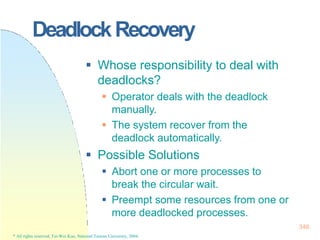

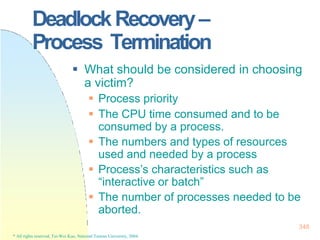





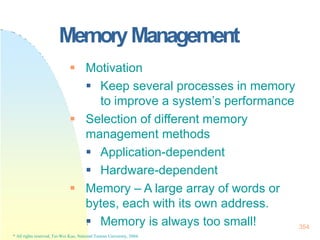


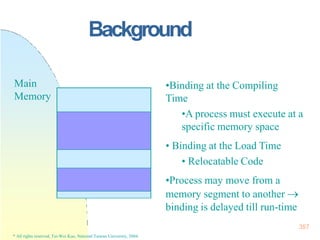




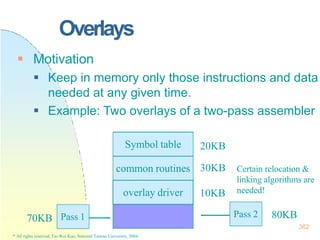


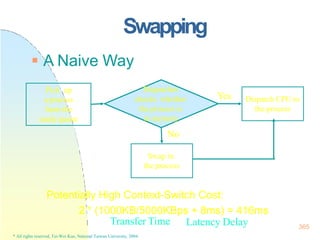






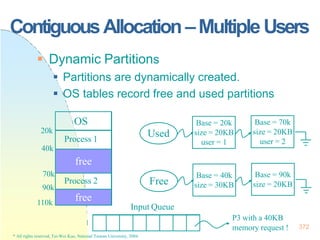













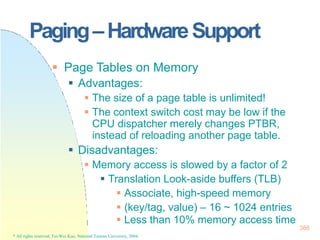
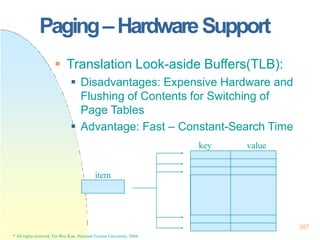

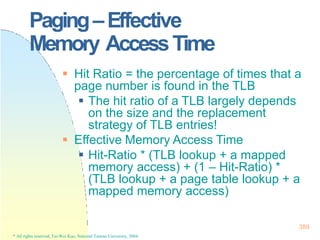







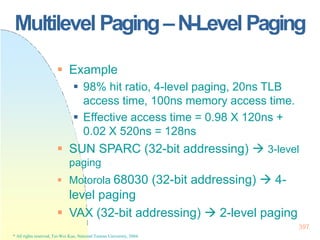



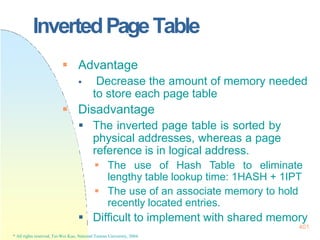
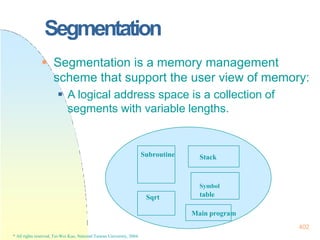






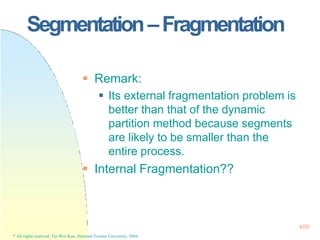



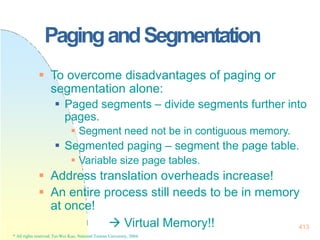























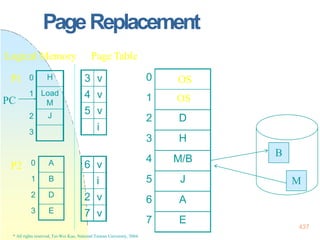

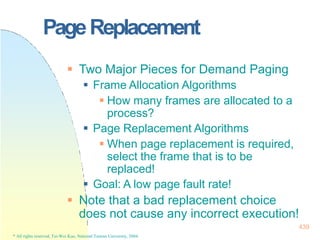



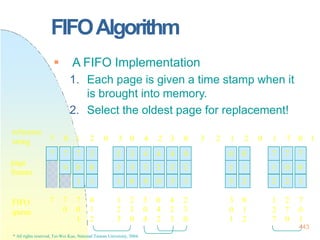







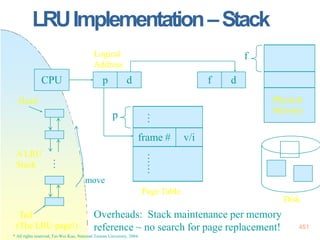


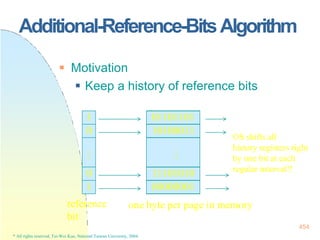

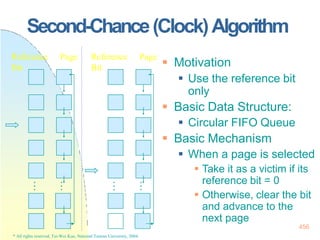
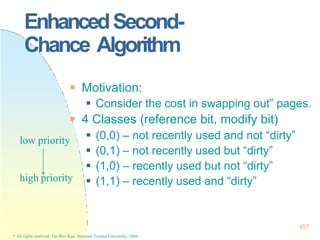


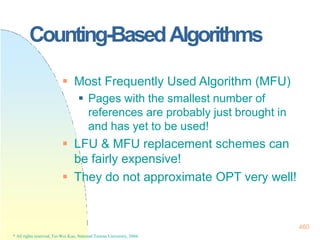

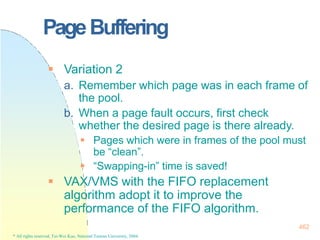

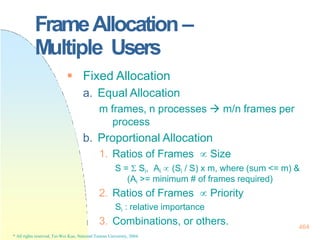



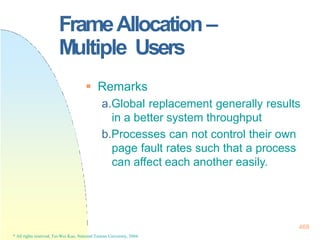



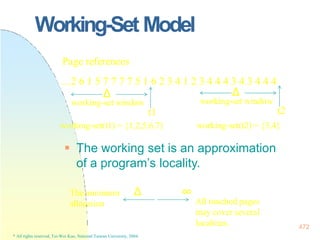









![128x128 page
faults if the
process has
less than 128
frames!!
482
Other Considerations
Program Structure
Motivation – Improve the system performance
by an awareness of the underlying demand
paging.
var A: array [1..128,1..128] of integer;
for j:=1 to 128
for i:=1 to 128
A(i,j):=0
A(1,1)
A(1,2)
.
.
A(1,128)
A(2,1)
A(2,2)
.
.
A(2,128)
A(128,1)
A(128,2)
.
.
A(128,128)
……
128
words
128 pages
* All rights reserved, Tei-Wei Kuo, National Taiwan University, 2004.](https://image.slidesharecdn.com/operatingsystemconceptspdfdrive-230209051248-f2ea019f/85/Operating-System-Concepts-PDFDrive-pptx-482-320.jpg)




